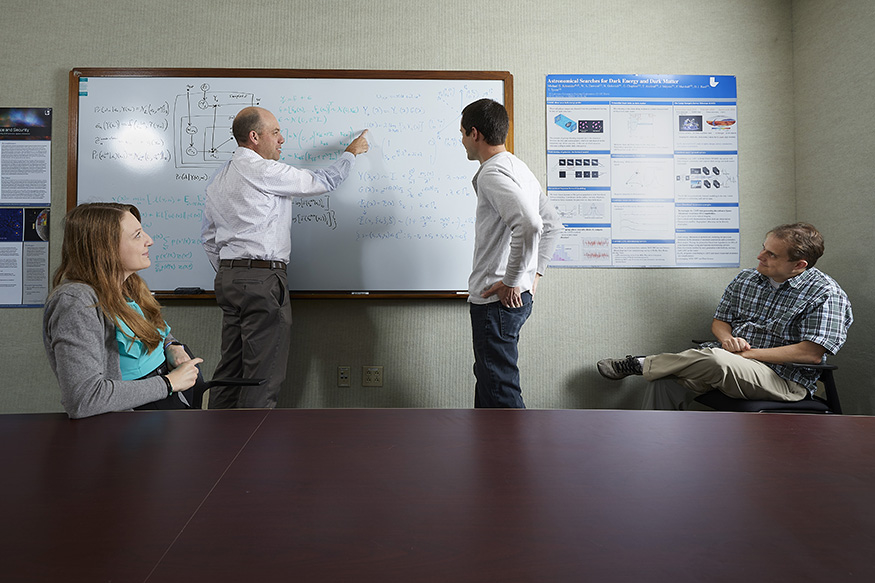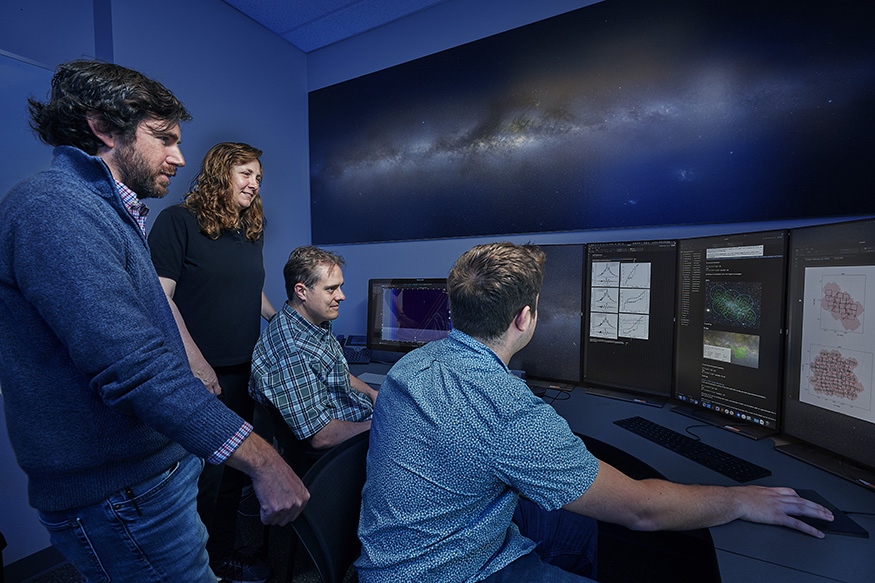Optical astronomy and cosmology
Lawrence Livermore researchers leverage synoptic surveys, statistical modeling and machine learning, and high-performance computing to close gaps in our understanding of how the universe works.
Telescopes and data science
Astrophysicists strive to understand fundamental characteristics of the solar system, our galaxy, and the universe to push the frontiers of our understanding of physics and the origin and evolution of the cosmos. They use telescopes and theoretical and numerical modeling to resolve some of the most pressing unanswered questions in physics, such as the unknown nature of dark energy.
In this field, data science helps researchers catalog and interpret objects of astronomical origin orbiting Earth as well as process huge volumes of data captured by ground- and space-based telescopes. Research in these areas leverages the substantial computational resources available at LLNL to apply image processing and inference algorithms—such as Bayesian statistical methods and machine learning—to optical telescope images and simulations.
Using these techniques, our researchers seek to:
Understand the nature of dark energy and dark matter using weak gravitational lensing of galaxies or investigating massive astrophysical compact halo objects (MACHOs)
Investigate Earth Trojan asteroids using image detection and orbit determination techniques
Explore adaptive optics capabilities and their applications for exoplanet discovery
Capabilities and collaborations for research
Processing high volumes of astronomical survey data is a major computational feat and requires executing large-scale simulations and developing scientifically meaningful machine learning algorithms. LLNL houses world-ranking supercomputers and advanced high-performance computing infrastructure, making it possible for our scientists to carry out such computational feats. The requirement for computational resources, coupled with the many applications between time-domain astronomy and space security, make LLNL scientists uniquely situated to perform cosmology and astronomy research.
In addition to advanced computing solutions, strategic collaborations and partnerships allow us to carry out meaningful and far-reaching astronomy and cosmology research. LLNL researchers play a central role in the Rubin Observatory Legacy Survey of Space Time (LSST) data processing pipeline, including leading working groups within the LSST Dark Energy Science Collaboration. We are also active in several other astronomy survey collaborations, including the Zwicky Transient Facility, and the Hyper Suprime-Cam survey.
As a result of LLNL’s extensive collaborations and computational resources, our researchers have been able to:
- Develop weak lensing shear analysis pipelines for LSST to support dark energy measurements.
- Discover new and efficient methods for finding black holes in the Milky Way.
- Design a multitude of robust machine learning techniques with applications such as star–galaxy image classification, asteroid orbit determination, and galaxy image deblending.
- Deploy big data pipelines on Livermore computing to search for potentially hazardous asteroids in astronomical survey data.
- Mentor university students to tackle real-world problems in the annual Data Science Challenge.
Research for national security
The immense volumes of data coming from new and improved astronomical instruments has necessitated development of novel methods to realize the potential of these surveys. The novel data science techniques developed by LLNL scientists for astronomy are also helping to push forward national security capabilities in space domain awareness and applications of artificial intelligence to the breadth of LLNL missions.
Image gallery
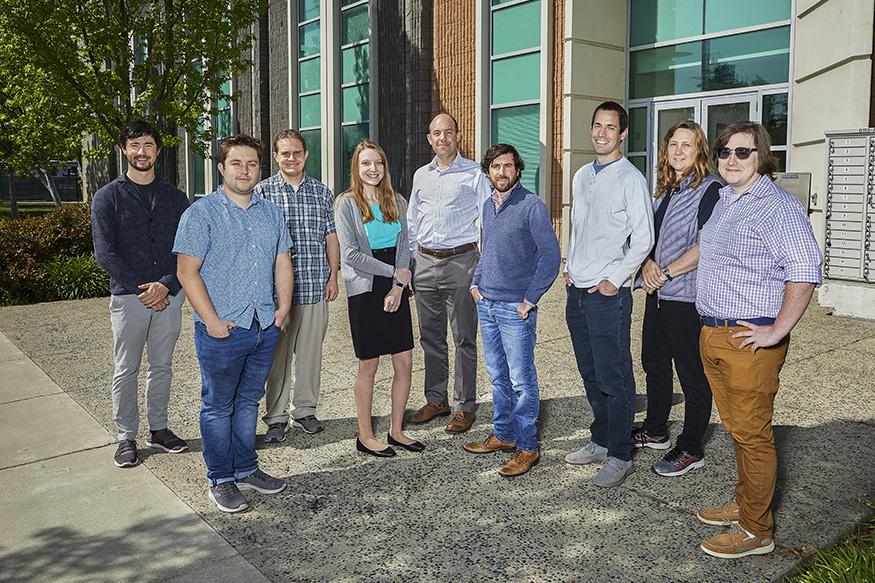

Members of the Astronomy and Astrophysics Analytics group at LLNL. From left: Nate Golovich, Ryan Dana, Bob Armstrong, Kerianne Pruett, Michael Schneider, Will Dawson, Eddie Schlafly, Carmen Carrano, and Travis Yeager.
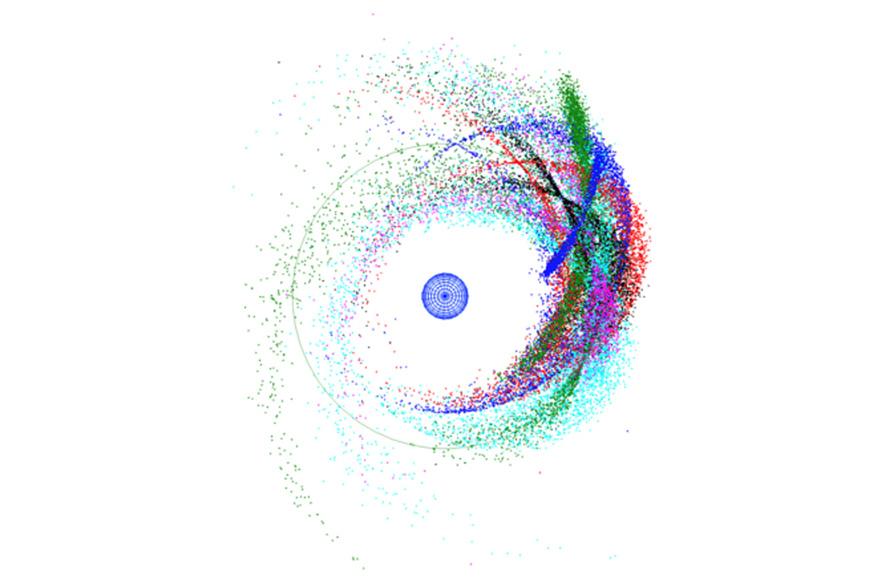

Data analytics algorithms generate probabilistic tracks of Earth-orbiting objects that are seen for only short time periods. The particle “clouds” shown here (represented by different colors for different objects) indicate the candidate positions for each object as projected into the future.
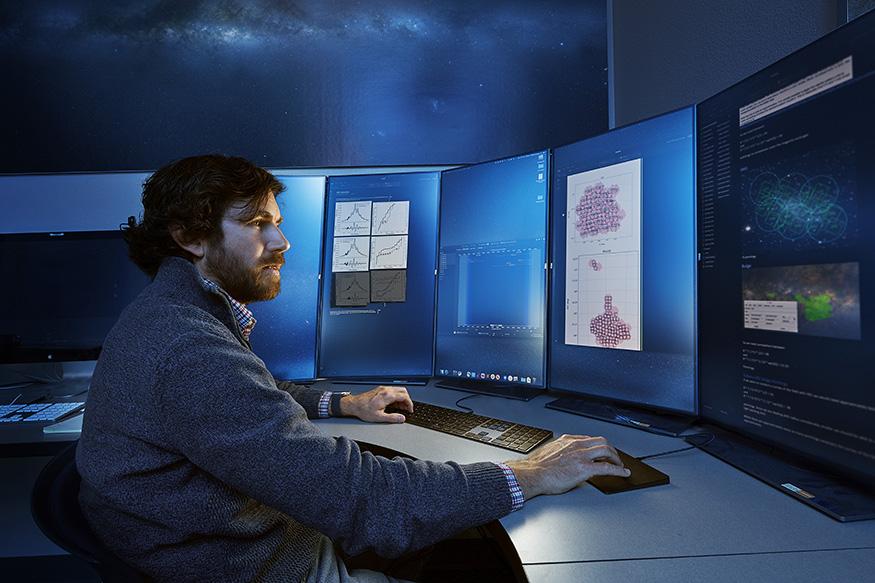

Astronomer Will Dawson drives the remote observing station.
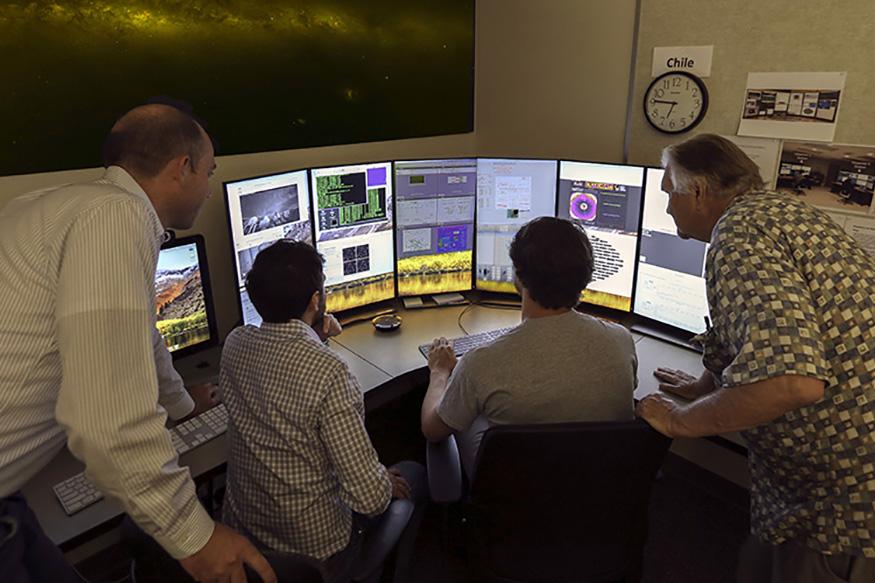

Michael Schneider, Will Dawson, Nathan Golovich, and George Chapline perform observations using the Dark Energy Camera (DECam) from the remote observing room at LLNL.
People
| Name | Title | Discipline |
|---|---|---|
| Team | ||
Collaborators
California Institute of Technology
Dark Energy Survey (DES)
HRL Laboratories
Hyper Suprime-Cam survey (HSC)
LSST Dark Energy Science Collaboration (DESC)
SLAC National Accelerator Laboratory
Space Telescope Science Institute
University of Arizona
University of California, Berkeley
University of California, Davis
University of California, Riverside
University of Michigan
Zwicky Transient Facility (ZTF)
Select publications
High-speed Focal Plane Wave Front Sensing with an Optical Chopper | Publications of the Astronomical Society of the Pacific, 2023
B.L. Gerard, D. Dillon, S. Cetre, and R. Jensen-Clem
Impact of point spread function higher moments error on weak gravitational lensing–II: A comprehensive study | Monthly Notices of the Royal Astronomical Society, 2023
T. Zhang, H. Almoubayyed, R. Mandelbaum, J.E. Meyers, M. Jarvis, A. Kannawadi, M.A. Schmitz, A. Guinot, and LSST Dark Energy Science Collaboration
A Reanalysis of Public Galactic Bulge Gravitational Microlensing Events from OGLE-III and IV | The Astrophysical Journal Supplement Series, 2022
N. Golovich, W. Dawson, F. Bartolic, C.Y. Lam, J.R. Lu, M.S. Medford, M.D. Schneider, G. Chapline, E.F. Schlafly, A. Drlica-Wagner, and K. Pruett
Gaussian Process Classification for Galaxy Blend Identification in LSST | The Astrophysical Journal, 2022
J.J. Buchanan, M.D. Schneider, R.E. Armstrong, A.L. Muyskens, B.W. Priest, and R.J. Dana
MEGASIM: Lifetimes and Resonances of Earth Trojan Asteroids—The Death of Primordial ETAs? | The Astrophysical Journal, 2022
T. Yeager and N. Golovich
Rare Events via Cross-Entropy Population Monte Carlo | IEEE Signal Processing Letters, 2022
C. Miller, J.N. Corcoran, and M.D. Schneider
Star-Galaxy Image Separation with Computationally Efficient Gaussian Process Classification | The Astrophysical Journal, 2022
A.L. Muyskens, I.R. Goumiri, B.W. Priest, M.D. Schneider, R.E. Armstrong, J. Bernstein, and R. Dana
The impact of tomographic redshift bin width errors on cosmological probes | Monthly Notices of the Royal Astronomical Society, 2022
I.S. Hasan, S.J. Schmidt, M.D. Schneider, J.A. Tyson
A Search for L4 Earth Trojan Asteroids Using a Novel Track-Before-Detect Multi-Epoch Pipeline | The Astronomical Journal, 2021
N. Lifset, N. Golovich, E. Green, R. Armstrong, and T. Yeager
Blending and obscuration in weak-lensing magnification | Monthly Notices of the Royal Astronomical Society, 2021
E. Gaztanaga, S.J. Schmidt, M.D. Schneider, and J.A. Tyson
Improving Astronomy Image Quality Through Real-Time Wavefront Estimation | Proceedings of the IEEE/CVF Conference on Computer Vision and Pattern Recognition (CVPR) Workshops, 2021
D. Thomas, J. Meyers, S.M. Kahn
MuyGPs: Scalable Gaussian Process Hyperparameter Estimation Using Local Cross-Validation | 2021
A. Muyskens, B. Priest, I. Goumiri, and M. Schneider
The LSST DESC DC2 Simulated Sky Survey | The Astrophysical Journal Supplement Series, 2021
The LSST Dark Energy Science Collaboration
Trigonometric Parallaxes of Two T Dwarfs With Keck and ShaneAO Astrometry | The Astronomical Society of the Pacific, 2021
J. Nguyen, S.M. Ammons, K. Dennison, E.V. Garcia, J.R. Lu, S. McMillan, and M. Salama
PopSyCLE: A New Population Synthesis Code for Compact Object Microlensing Events | The Astrophysical Journal, 2020
C.Y. Lam, J.R. Lu, M.W. Hosek Jr., W.A. Dawson, and N.R. Golovich
Reinforcement Learning via Gaussian Processes with Neural Network Dual Kernels | 2020 IEEE Conference on Games, 2020
I. Goumiri, B. Priest, and M.D. Schneider
The Gemini Planet Imager Exoplanet Survey: Giant Planet and Brown Dwarf Demographics from 10 to 100 au | The American Astronomical Society, 2019
E.L. Nielsen et al
Design of optical systems that maximize as-built performance using tolerance/compensator-informed optimization | Optics Express, 2018
B.J. Bauman and M.D. Schneider
Probabilistic Cosmological Mass Mapping from Weak Lensing Shear | The Astrophysical Journal, 2017
M.D. Schneider, K.Y. Ng, W.A. Dawson, P.J. Marshall, J.E. Meyers, and D.J. Bard
The Hyper Suprime-Cam Software Pipeline | Publications of the Astronomical Society of Japan, 2017
J. Bosch et al
An accurate and practical method for inference of weak gravitational lensing from galaxy images | Monthly Notices of the Royal Astronomical Society, 2016
G.M. Bernstein, R. Armstrong, C. Krawiec, M.C. March
Hierarchical Probabilistic Inference of Cosmic Shear | The Astrophysical Journal, 2015
M.D. Schneider, D.W. Hogg, P.J. Marshall, W.A. Dawson, J. Meyers, D.J. Bard, and D. Lang

